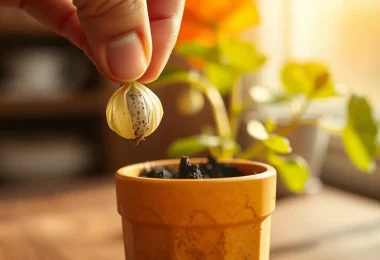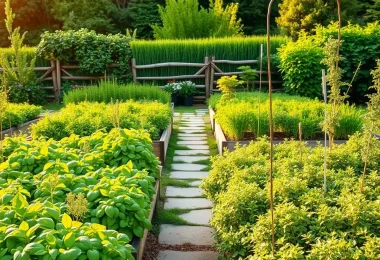Creeping myrtle, also known as Vinca minor, is a versatile and low-growing groundcover plant. It thrives in gardens across the United Kingdom. This guide will give you all the info you need to grow and care for this hardy perennial.
You’ll learn about its characteristics, the best growing conditions, watering needs, and pruning techniques. This article will help you add creeping myrtle to your garden and landscaping projects.

Key Takeaways
- Creeping myrtle is a low-growing, evergreen groundcover plant that thrives in shady to partially shaded areas.
- It requires well-drained soil and prefers a slightly acidic pH.
- Proper watering and fertilising are essential for the plant’s health and growth.
- Regular pruning helps maintain the desired appearance and prevent the plant from becoming overgrown.
- Creeping myrtle can be easily propagated through division or cuttings.
Creeping Myrtle: An Evergreen Groundcover
Creeping myrtle, also known as Vinca minor, is a lovely evergreen perennial. It thrives as a groundcover in gardens across the United Kingdom. This plant has lush, glossy green leaves and produces charming violet-blue flowers in the spring. These flowers add a touch of natural beauty to any outdoor space.
Description and Characteristics
Creeping myrtle is a fast-growing, mat-forming groundcover. It can quickly spread to cover bare soil and suppress unwanted weeds. Its trailing stems can reach up to 18 inches in length, creating a dense, carpet-like appearance. The dark green, evergreen foliage remains vibrant throughout the year, providing year-round visual interest in the garden.
related: How to Grow Ceanothus: Essential Tips for Success
“Creeping myrtle is a true workhorse in the garden, offering a low-maintenance solution to common landscaping challenges.”
In addition to its attractive appearance, creeping myrtle is also resilient and hardy. It can tolerate a wide range of soil conditions, from full sun to partial shade. This makes it an ideal choice for a variety of garden settings. With its ability to quickly spread and fill in gaps, creeping myrtle is a popular groundcover choice for gardeners. They look to add a touch of evergreen elegance to their outdoor spaces.
Choosing the Right Planting Site
When picking a spot for your creeping myrtle, think about a few key things. This hardy, evergreen groundcover does best in the right spot. So, picking the perfect planting site in your garden is very important.
Creeping myrtle likes partial shade to full sun, depending on where you live. If it’s very sunny, it needs some shade. But in cooler places, it can handle more sun. Look at how much sun your spot gets and pick the right one for your creeping myrtle’s needs.
Also, the soil needs to be well-drained and moist, with lots of organic matter. Don’t plant it where water collects, as it doesn’t like wet feet. Before you plant, check the soil and add anything it needs to grow well.
“Creeping myrtle is a low-maintenance, versatile groundcover that can brighten up shaded areas of the garden with its evergreen foliage and delicate blue flowers.”
By picking the right planting site and making sure it’s what creeping myrtle needs, you’ll have a beautiful groundcover. It will make your garden look great for many years.

Soil Preparation for Creeping Myrtle
Getting the soil right is key for creeping myrtle to grow well. Before planting, check the soil’s pH and texture. It should be slightly acidic to neutral, between 5.5 and 7.0. This pH helps the plant absorb nutrients from the soil.
If your soil’s pH is off, add organic matter like compost or well-rotted manure. This improves drainage, fertility, and water retention. These are all important for creeping myrtle’s growth.
Amending the Soil
To get your soil ready for creeping myrtle, follow these steps:
- Test the soil’s pH with a kit or send a sample to a lab. This tells you if it needs adjusting.
- If it’s too acidic, add lime. For too alkaline, use sulphur or aluminium sulphate.
- Mix in 2-4 inches (5-10 cm) of organic matter into the top soil layer. This boosts drainage, aeration, and nutrients.
- Rake the soil to make it smooth and even, ready for planting.
By properly preparing the soil, you’ll give your creeping myrtle the best start. It will grow lush and healthy, lasting for many years.

Planting Creeping Myrtle
Timing is key when planting creeping myrtle. The best times are spring or autumn. This is when the soil is moist and the weather is mild. It helps the plants grow strong roots and flourish in your garden.
Space the plants 12 to 18 inches apart. This gives them room to spread and cover the ground well. Make sure to plant them at the same depth as in their containers. This helps them adjust better.
After planting, gently press the soil around the roots. This ensures a good connection between the soil and roots. It’s vital for the plants to grow well.

- Prepare the soil by adding compost or well-rotted manure. This improves drainage and nutrient levels.
- Water the plants well after planting. This settles the soil and gives them the moisture they need.
- Mulch around the plants to keep moisture in and weeds out. But, make sure the mulch doesn’t touch the stems.
By following these steps, you can have a beautiful and lush creeping myrtle groundcover in your garden.
Watering Needs of Creeping Myrtle
Keeping the right amount of moisture is key for creeping myrtle to grow well. When it’s new, the soil should be moist but not too wet. This balance helps the roots grow strong.
As creeping myrtle gets older, it can handle dry spells better. But, it still needs extra watering during long dry times. This keeps its leaves green and healthy.
To sum up, creeping myrtle needs:
- Soil that’s moist but not too wet in the first year
- It can handle dryness once it’s grown
- Extra watering when it’s very dry to keep it looking good
Adjusting the watering based on the plant’s age and the weather helps it grow. This makes your gardening area look even better.

Fertilising Creeping Myrtle
To keep your creeping myrtle healthy and growing, you need to fertilise it regularly. You can choose between organic and inorganic fertilisers. Each has its own benefits for your groundcover.
Organic vs. Inorganic Fertilisers
Organic fertilisers like compost or manure give nutrients slowly to your creeping myrtle. They also make the soil better, helping the roots grow strong. On the other hand, inorganic fertilisers give a quick boost of nutrients. But, you might need to use them more often.
| Organic Fertilisers | Inorganic Fertilisers |
|---|---|
| Slow-release of nutrients | Immediate nutrient boost |
| Improves soil structure | Requires more frequent application |
| Natural sources (e.g., compost, manure) | Synthetic, concentrated formulas |
When picking between organic and inorganic fertilisers, think about what you prefer. Also, consider what your plants need and the soil’s condition. The right nutrients will help your creeping myrtle stay lush and green all year.
Pruning and Maintaining Creeping Myrtle
Maintaining creeping myrtle (Vinca minor) is key to its lush look. This evergreen groundcover adds greenery to gardens but needs regular care. With a few simple steps, gardeners can keep it neat and tidy all year.
Prune creeping myrtle in spring or early autumn. This allows it to recover and grow well. Start by looking for stems that are too long or out of place. Use sharp shears to cut them off, but don’t harm the plant’s core.
- Remove dead, damaged, or discoloured leaves for a healthy look.
- Keep the height between 4-6 inches (10-15 cm) for the best look.
- Don’t cut too much, as it can stress the plant and slow its growth.
Regular maintenance is also crucial for creeping myrtle. Gently rake the surface to remove leaves and debris. This helps the plant spread and thrive. Also, watch for pests or diseases and deal with them quickly to keep the plant healthy.
| Task | Frequency |
|---|---|
| Pruning | Spring or early autumn |
| Raking and debris removal | Regularly, as needed |
| Pest and disease monitoring | Ongoing |
With regular care, creeping myrtle will keep its lush look for years. A bit of pruning and attention will make it thrive in any outdoor space.

Propagating Creeping Myrtle
Creeping myrtle, also known as periwinkle, is a versatile and easy-to-grow groundcover. It can be readily propagated through division or transplanting. This evergreen plant thrives in a wide range of growing conditions. It’s a popular choice for gardeners and landscapers alike.
Dividing and Transplanting Creeping Myrtle
One of the most effective methods of propagating creeping myrtle is through division. In the springtime or autumn, gently dig up a section of the plant. Carefully divide it into smaller, manageable clumps. Ensure each division has a healthy root system before replanting them in their desired locations.
Another option for propagation is transplanting. Simply select a healthy section of the creeping myrtle plant, dig it up, and replant it in a new area. This approach allows you to expand the coverage of your groundcover or fill in any bare spots in your garden.
Regardless of the propagation method you choose, it is essential to water the divided or transplanted sections thoroughly. Monitor them closely for the first few weeks to ensure successful establishment. With a little care and attention, your creeping myrtle will continue to thrive and spread. It will provide a lush, low-maintenance groundcover for years to come.
“Creeping myrtle is a remarkably resilient and adaptive plant, making it an excellent choice for gardeners looking to create a vibrant, low-growing groundcover.”
Creeping Myrtle as a Groundcover
Creeping myrtle is great as a groundcover. It spreads out to cover bare soil and fill gaps between stones. It also looks good cascading over walls or slopes. This plant is loved for keeping weeds away and staying green all year.
The leaves of creeping myrtle form a dense carpet. This carpet spreads quickly, making it easy to cover large areas. Its leaves stay green all year, adding beauty to any garden.
Creeping myrtle is also good for stopping soil erosion. Its stems and roots hold the soil in place. This is especially helpful on slopes or hillsides.
| Benefit | Description |
|---|---|
| Groundcover | Creeping myrtle’s dense, mat-forming growth habit makes it an excellent choice for covering bare soil and filling in between stepping stones. |
| Weed Suppression | The thick, evergreen foliage of creeping myrtle helps to smother and suppress the growth of weeds, reducing the need for frequent maintenance. |
| Erosion Control | The trailing stems and deep root system of creeping myrtle help to stabilise the soil and prevent soil loss on slopes or hillsides. |
Looking to cover a bare spot or create a lush carpet in your garden? Creeping myrtle is a top pick. It’s reliable and versatile as a groundcover.
Pests and Diseases of Creeping Myrtle
Creeping myrtle is usually a hardy groundcover. But, it can get pests and diseases. It’s important to watch for these and treat them fast to keep your garden looking good.
Identifying and Treating Common Issues
Aphids often visit creeping myrtle. These tiny insects suck sap and can harm the plants. Use insecticidal soap or neem oil to control them.
Spider mites are another problem. They love dry conditions and eat the leaves. Mist the plants and use horticultural oil or insecticidal soap to fight them.
Fungal diseases like powdery mildew and leaf spot can also occur. Improve air flow, water right, and use fungicides to prevent and treat these.
Bacterial leaf spot causes water-soaked spots on leaves. Use copper-based bactericides and ensure good air flow to tackle this.
Being quick to spot and treat pests and diseases is crucial. This way, you can keep your creeping myrtle healthy and vibrant in your garden.
Companion Plants for Creeping Myrtle
Creeping myrtle is a versatile evergreen groundcover that looks great with other plants. It’s perfect for adding colour and shade to your garden. The right plants can make your garden even more beautiful.
For a lush look, pair creeping myrtle with ferns, hostas, or hellebores. These plants love the same conditions as creeping myrtle. They work together beautifully.
To brighten up your garden, try adding primroses, violets, or forget-me-nots. Their flowers will look stunning against the evergreen leaves of creeping myrtle. It’s a beautiful sight.
| Companion Plant | Growing Conditions | Benefits |
|---|---|---|
| Ferns | Partial to full shade, moist, well-drained soil | Creates a lush, woodland-like setting with creeping myrtle |
| Hostas | Partial to full shade, rich, moist soil | Adds a textural contrast to the creeping myrtle’s foliage |
| Hellebores | Partial shade, well-drained, humus-rich soil | Provides early spring blooms to complement creeping myrtle’s evergreen carpet |
| Primroses | Partial shade, moist, well-drained soil | Adds a pop of vibrant colour to the garden with creeping myrtle |
| Violets | Partial shade, moist, well-drained soil | Complements the creeping myrtle’s foliage with delicate blooms |
| Forget-me-nots | Partial shade, moist, well-drained soil | Creates a charming, cottage-garden feel with creeping myrtle |
Choosing the right companion plants can make your garden look amazing. Creeping myrtle is very versatile. It can be part of many beautiful garden designs.
Remember, the key to great companion planting is to pick plants that like the same conditions. This way, they can grow well together and make your garden look even better.
Overwintering Creeping Myrtle
In colder areas, gardeners need to protect their creeping myrtle plants during winter. A layer of mulch around the base is key. It keeps the roots warm and safe from frost.
Also, prune dead or damaged leaves in spring. This helps the plant grow new, healthy parts. It’s a simple way to keep your creeping myrtle looking good all year in the UK.
Creeping myrtle is loved for its toughness and ability to adapt. With proper care, it can handle winter’s cold. Protecting the roots and encouraging new growth ensures it stays vibrant and green all year.
FAQ
What is creeping myrtle and what are its characteristics?
Creeping myrtle, also known as Vinca minor, is a groundcover. It has dark green, glossy leaves and violet-blue flowers in spring. It spreads quickly, making a dense mat.
This makes it great for covering soil, suppressing weeds, and adding beauty to gardens.
What type of planting site is best for creeping myrtle?
Choose a spot with the right sunlight and soil. Creeping myrtle likes partial shade to full sun. It also needs well-drained, moist soil rich in organic matter.
How do I prepare the soil for planting creeping myrtle?
Before planting, check the soil’s pH and texture. Aim for a slightly acidic to neutral pH (5.5 to 7.0). Add compost or well-rotted manure to improve drainage and fertility.
When and how should I plant creeping myrtle?
Plant in spring or autumn when the soil is moist and mild. Space plants 12-18 inches apart. Plant at the same depth as in containers. Firm the soil gently around the plants.
How much water does creeping myrtle need?
Creeping myrtle needs consistent, moderate watering. Keep the soil moist but not waterlogged in the first year. It’s drought-tolerant once established but benefits from extra water during dry spells.
What type of fertiliser should I use for creeping myrtle?
Fertilise creeping myrtle periodically to support its growth. Use organic or inorganic fertilisers. Organic options like compost provide nutrients slowly and improve soil structure. Inorganic fertilisers give a quick nutrient boost but need more frequent application.
How do I prune and maintain creeping myrtle?
Prune regularly to keep creeping myrtle tidy and promote dense growth. Trim back wayward stems and remove dead foliage in spring or early autumn. Avoid severe cutting to prevent damage.
How can I propagate creeping myrtle?
Propagate creeping myrtle by division or transplanting. Dig up a section in spring or autumn, divide it, and replant the divisions. Water well and monitor for establishment.
What are some common pests and diseases that affect creeping myrtle?
Creeping myrtle can face pests like aphids and spider mites, and diseases like fungal infections and bacterial leaf spot. Spot these issues early and treat them to keep your plants healthy.
What are good companion plants for creeping myrtle?
Creeping myrtle goes well with shade-loving perennials like ferns and hostas. It also complements flowering plants like primroses and forget-me-nots, adding colour to your garden.
How do I overwinter creeping myrtle?
In cold climates, creeping myrtle needs extra care in winter. Mulch around the plants to protect the roots from frost. Cut back dead foliage in spring to encourage new growth.









